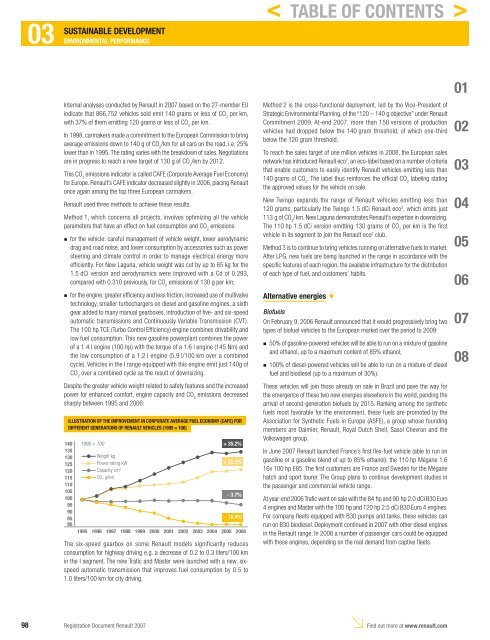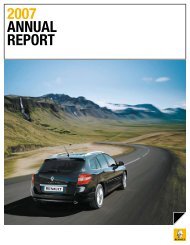2007 Interactive Registration Document - Renault
2007 Interactive Registration Document - Renault
2007 Interactive Registration Document - Renault
Create successful ePaper yourself
Turn your PDF publications into a flip-book with our unique Google optimized e-Paper software.
03 ENVIRONMENTAL<br />
SUSTAINABLE DEVELOPMENT<br />
PERFORMANCE<br />
Internal analyses conducted by <strong>Renault</strong> in <strong>2007</strong> based on the 27-member EU<br />
indicate that 866,752 vehicles sold emit 140 grams or less of CO 2 per km,<br />
with 37% of them emitting 120 grams or less of CO 2 per km.<br />
In 1998, carmakers made a commitment to the European Commission to bring<br />
average emissions down to 140 g of CO 2 /km for all cars on the road, i.e. 25%<br />
lower than in 1995. The rating varies with the breakdown of sales. Negotiations<br />
are in progress to reach a new target of 130 g of CO 2 /km by 2012.<br />
This CO 2 emissions indicator is called CAFE (Corporate Average Fuel Economy)<br />
for Europe. <strong>Renault</strong>’s CAFE indicator decreased slightly in 2006, placing <strong>Renault</strong><br />
once again among the top three European carmakers.<br />
<strong>Renault</strong> used three methods to achieve these results.<br />
Method 1, which concerns all projects, involves optimizing all the vehicle<br />
parameters that have an effect on fuel consumption and CO 2 emissions:<br />
n<br />
n<br />
for the vehicle: careful management of vehicle weight, lower aerodynamic<br />
drag and road noise, and lower consumption by accessories such as power<br />
steering and climate control in order to manage electrical energy more<br />
effi ciently. For New Laguna, vehicle weight was cut by up to 65 kg for the<br />
1.5 dCi version and aerodynamics were improved with a Cd of 0.293,<br />
compared with 0.310 previously, for CO 2 emissions of 130 g per km;<br />
for the engine: greater effi ciency and less friction, increased use of multivalve<br />
technology, smaller turbochargers on diesel and gasoline engines, a sixth<br />
gear added to many manual gearboxes, introduction of fi ve- and six-speed<br />
automatic transmissions and Continuously Variable Transmission (CVT).<br />
The 100 hp TCE (Turbo Control Effi ciency) engine combines drivability and<br />
low fuel consumption. This new gasoline powerplant combines the power<br />
of a 1.4 l engine (100 hp) with the torque of a 1.6 l engine (145 Nm) and<br />
the low consumption of a 1.2 l engine (5.9 l/100 km over a combined<br />
cycle). Vehicles in the I range equipped with this engine emit just 140g of<br />
CO 2 over a combined cycle as the result of downsizing.<br />
Despite the greater vehicle weight related to safety features and the increased<br />
power for enhanced comfort, engine capacity and CO 2 emissions decreased<br />
sharply between 1995 and 2006:<br />
ILLUSTRATION OF THE IMPROVEMENT IN CORPORATE AVERAGE FUEL ECONOMY (CAFE) FOR<br />
DIFFERENT GENERATIONS OF RENAULT VEHICLES (1995 = 100)<br />
140<br />
135<br />
130<br />
125<br />
120<br />
115<br />
110<br />
105<br />
100<br />
95<br />
90<br />
85<br />
80<br />
1995 = 100<br />
Weight kg<br />
Power rating kW<br />
Capacity cm3 CO2 g/km<br />
+ 35.2%<br />
+ 22.2%<br />
- 3.7%<br />
- 18.4%<br />
1995 1996 1997 1998 1999 2000 2001 2002 2003 2004 2005 2006<br />
The six-speed gearbox on some <strong>Renault</strong> models significantly reduces<br />
consumption for highway driving e.g. a decrease of 0.2 to 0.3 liters/100 km<br />
in the I segment. The new Trafi c and Master were launched with a new, sixspeed<br />
automatic transmission that improves fuel consumption by 0.5 to<br />
1.0 liters/100 km for city driving.<br />
Method 2 is the cross-functional deployment, led by the Vice-President of<br />
Strategic Environmental Planning, of the “120 – 140 g objective” under <strong>Renault</strong><br />
Commitment 2009. At-end <strong>2007</strong>, more than 150 versions of production<br />
vehicles had dropped below the 140 gram threshold, of which one-third<br />
below the 120 gram threshold.<br />
To reach the sales target of one million vehicles in 2008, the European sales<br />
network has introduced <strong>Renault</strong> eco 2 , an eco-label based on a number of criteria<br />
that enable customers to easily identify <strong>Renault</strong> vehicles emitting less than<br />
140 grams of CO 2 . The label thus reinforces the offi cial CO 2 labeling stating<br />
the approved values for the vehicle on sale.<br />
New Twingo expands the range of <strong>Renault</strong> vehicles emitting less than<br />
120 grams, particularly the Twingo 1.5 dCi <strong>Renault</strong> eco 2 , which emits just<br />
113 g of CO 2 / km. New Laguna demonstrates <strong>Renault</strong>’s expertise in downsizing.<br />
The 110 hp 1.5 dCi version emitting 130 grams of CO 2 per km is the fi rst<br />
vehicle in its segment to join the <strong>Renault</strong> eco 2 club.<br />
Method 3 is to continue to bring vehicles running on alternative fuels to market.<br />
After LPG, new fuels are being launched in the range in accordance with the<br />
specifi c features of each region, the available infrastructure for the distribution<br />
of each type of fuel, and customers’ habits.<br />
Alternative energies ✦<br />
Biofuels<br />
On February 9, 2006 <strong>Renault</strong> announced that it would progressively bring two<br />
types of biofuel vehicles to the European market over the period to 2009:<br />
50% of gasoline-powered vehicles will be able to run on a mixture of gasoline<br />
and ethanol, up to a maximum content of 85% ethanol;<br />
100% of diesel-powered vehicles will be able to run on a mixture of diesel<br />
fuel and biodiesel (up to a maximum of 30%).<br />
These vehicles will join those already on sale in Brazil and pave the way for<br />
the emergence of these two new energies elsewhere in the world, pending the<br />
arrival of second-generation biofuels by 2015. Ranking among the synthetic<br />
fuels most favorable for the environment, these fuels are promoted by the<br />
Association for Synthetic Fuels in Europe (ASFE), a group whose founding<br />
members are Daimler, <strong>Renault</strong>, Royal Dutch Shell, Sasol Chevron and the<br />
Volkswagen group.<br />
In June <strong>2007</strong> <strong>Renault</strong> launched France’s fi rst fl ex-fuel vehicle (able to run on<br />
gasoline or a gasoline blend of up to 85% ethanol): the 110 hp Mégane 1.6<br />
16v 100 hp E85. The fi rst customers are France and Sweden for the Mégane<br />
hatch and sport tourer. The Group plans to continue development studies in<br />
the passenger and commercial vehicle range.<br />
At year-end 2006 Trafi c went on sale with the 84 hp and 90 hp 2.0 dCi B30 Euro<br />
4 engines and Master with the 100 hp and 120 hp 2.5 dCi B30 Euro 4 engines.<br />
For company fl eets equipped with B30 pumps and tanks, these vehicles can<br />
run on B30 biodiesel. Deployment continued in <strong>2007</strong> with other diesel engines<br />
in the <strong>Renault</strong> range. In 2008 a number of passenger cars could be equipped<br />
with these engines, depending on the real demand from captive fl eets.<br />
98 <strong>Registration</strong> <strong>Document</strong> <strong>Renault</strong> <strong>2007</strong><br />
Find out more at www.renault.com<br />
n<br />
n<br />
< TABLE OF CONTENTS ><br />
01<br />
02<br />
03<br />
04<br />
05<br />
06<br />
07<br />
08




